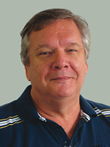The symposium was attended by various experts in the water management industry.
 Rio Tinto's Rössing Uranium mine formed part of the discussion and shared its knowledge on water in mining. André Genis (pictured left), General Manager, Engineering and Projects at Rössing Uranium mine discussed topics ranging from the importance of water in mining projects, the effects of mining on water demand, water recycling at Rössing and the expansion requirements of water in the Erongo region.
Rio Tinto's Rössing Uranium mine formed part of the discussion and shared its knowledge on water in mining. André Genis (pictured left), General Manager, Engineering and Projects at Rössing Uranium mine discussed topics ranging from the importance of water in mining projects, the effects of mining on water demand, water recycling at Rössing and the expansion requirements of water in the Erongo region.
Genis is a registered professional engineer. On the context of his presentation, he said: “I base my comments on my years of work in the water supply industry which included the design, construction and commissioning of the water supply infrastructure to Scorpion Mine, Langer Heinrich Mine, the negotiation with Uramin (now Areva) regarding the desalination plant in its infancy, and the last couple of years being responsible for the development of expansion and new projects at Rössing.”
At Rössing water plays a vital role in mining operations. Water use for 2009 was lower than expected, at a rate of 0.24 m3/t of ore milled, against a target of 0.26 m3/t of ore milled. In the same year the mine's freshwater use was 3.1 million m3, or 8,578 m3/day, while the operating plan made provision for 3.2 million m3, or 8,780 m3/day. This was due to the freshwater savings projects implemented in 2008 and the water savings awareness drive urging employees to use this precious resource sparingly.
In his presentation, Genis highlighted that “a water awareness programme was launched in 1998 to increase employees' understanding of the need to save water at work and at home. This resulted in a 50% reduction in water consumption on the mine.
He further added that “the single biggest effect on water demand in a region would be the development of a mine, however often the secondary effects are ignored, such as increased housing requirements with its domestic water demand and increased support services such as schools, hospitals and shops,” among others.
Genis added that even though Rössing and the region have enjoyed a good level of success in the management of water over the years, there has been a downside to their success.
“Operating mines in the region have all had to stop all activities due to lack of water twice in this year. Furthermore, NamWater's own analyses show that there could be shortages in supply in 2010. Doubts about the ability to react in time have resulted in Areva building its own desalination plant.”
The Institute of Charted Accountants in Namibia (ICAN) in partnership with several stakeholders celebrates Namibia Accountancy Week from 7 to 13 March 2010.
Genis concluded that “companies cannot afford to regard water as an inexpensive commodity; rather it is a shared resource and all must collaborate to ensure society uses it to the greatest benefit.”
He added that Rössing has done a lot over the years to curb its water usage. “A major decision in 1980 resulted in a recycling programme. The Mine currently recycles about 60 to 70% of its water.
About Rössing Uranium Mine
Rössing Uranium Limited is a large open-pit uranium mine that forms part of the Rio Tinto group of companies. The mine started operating in 1976 and encompasses a licence area of 180 km2 of which 20 km2 is used for mining, waste disposal and processing. Rössing mines, processes and exports uranium oxide to approved electricity generators worldwide and has a nameplate capacity of 4500 tonnes of uranium per year, making it the third largest open pit mine in the world.
Issued by:
Jerome Mutumba
Manager Corporate Communications and External Relations
Tel 064 520 1080